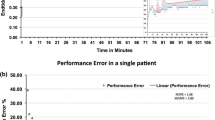Abstract
A mathematical model consisting of six well-mixed tissue compartments was used for prediction of an anesthetic dose rate designed to maintain a constant arterial halothane concentration during closed-circuit anesthesia with halothane and nitrous oxide. Metabolism of anesthetics was not considered they were regarded as inert. Calculated rates of vapor were administered to provide a predicted level of anesthesia in 20 normal individuals during elective surgery. Arterial blood samples of these individuals were obtained periodically and analyzed for halothane to determine the relevance of the model to clinical anesthesia. The calculated dosage schedule was shown to predict clinical findings with acceptable accuracy in these patients. The assumption that arterial anesthetic concentration reflects instantaneous equilibration with cell receptors where anesthetics exert their effect in the brain was thus found to be justified by the clinical trial. In addition, we used the calculated anesthetic dosage schedule, which applies to a typical patient anesthetized under total-rebreathing conditions, as an input for an analog computer representing the six-compartment model, and we investigated effects of deviations between the predicted parameter values and actual clinical values of fat-to-muscle ratios and respiratory parameters upon the anesthetic levels obtained. The computer analysis suggests that respiratory factors such as lung shunts and dead space have little effect on patient response to closed-circuit anesthesia, in contrast to the effects observed in association with nonrebreathing techniques.
Similar content being viewed by others
References
Allot, P. R., Steward, A., and Mapleson, W. W. Pharmacokinetics of halothane in the dog. Comparison of theory and measurement in individuals.British Journal of Anaesthesia 1976,48, 279–295.
Ashman, M. N., Blesser, W. B., and Epstein, R. M. A nonlinear model for the uptake and distribution of halothane in man.Anesthesiology 1970,33, 419–429.
Dost, F. H.Der Blutspiegel. Leipzig: Thieme, 1953.
Dost, F. H.Grundlagen der Pharmakokinetik. Stuttgart: Thieme, 1968.
Eger, E. I. A mathematical model of uptake and distribution. In E. M. Papper and R. J. Kitz (Eds.), Uptake and distribution of anesthetic agents. New York: McGraw-Hill, 1963, Pp. 72–87, 115.
Eger, E. I., and Bahlman, S. H. Is the end-tidal anesthetic partial pressure an accurate measure of the arterial anesthetic partial pressure?Anesthesiology 1971,35, 301–303.
Eger, E. I., Bahlman, S. H., Halsey, M. J., and Sawyer, D. C. The effect of distribution of increased cardiac output on the pulmonary exchange of halothane, nitrous oxide, and methoxyflurane.Anesthesia and Analgesia (Cleveland) 1973,52, 625–629.
Eger, E. I., II, and Guadagni, N. P. Halothane uptake in man at constant alveolar concentration.Anesthesiology 1963,24, 299–304.
Haggard, A. W. The absorption, distribution and elimination of ethyl ether.Journal of Biological Chemistry 1924,59, 753–771.
Kolmer, H. H., Burm, A. G., Cramers, C. A.,et al. The uptake and elimination of halothane in dogs: a two or multicompartment system? II. Evaluation of wash-in and wash-out curves.British Journal of Anaesthesia 1975,47, 1169.
Lin, C. Y., and Mostert, J. W. Inspired O2 and N2O concentrations in essentially closed circuits.Anaesthesis 1977,26, 514–517.
Lowe, H. J.Dose-regulated penthrane anesthesia. Chicago: Abbott Laboratories, 1972.
Lowe, H. J. Flame ionization detection of volatile organic anesthetics in blood gases and tissue.Anesthesiology 1964,25, 808–814.
MacKrell, T. N. Guest discussion.Anesthesia and Analgesia (Cleveland) 1973,52, 629–631.
Mapleson, W. W. An electric analogue for uptake and exchange of inert gases and other agents.Journal of Applied Physiology 1963,18, 197–204.
Mostert, J. W., Goldberg, I. S., Lanzl, E. F., and Lowe, H. J. Das geschlossene System.Anaesthesist 1977,26, 495–502.
Smith, N. T., Zwart, A. and Beneken, J. E. W. Interaction between the circulatory effects and the uptake and distribution of halothane: Use of a multiple model.Anesthesiology 1972,37, 47–58.
Zwart, A., Smith, N. T., and Beneken, J. E. W. Multiple model approach to uptake and distribution of halothane. The use of an analog computer.Computers and Biomedical Research 1972,5, 228–238.
Author information
Authors and Affiliations
Additional information
Franklin McLean Memorial Research Institute, operated by The University of Chicago for the U. S. Department of Energy under Contract No. EY-76-C-02-0069
Supported in part by Public Health Service Research Grant ES-00855-020 and Grant 2R01-CA06475 from the National Cancer Institute.
Rights and permissions
About this article
Cite this article
Goldberg, I.S., Mostert, J.W., Lanzl, E.F. et al. A pharmacokinetic model of closed-circuit inhalation anesthesia. Ann Biomed Eng 6, 231–249 (1978). https://doi.org/10.1007/BF02409345
Received:
Revised:
Issue Date:
DOI: https://doi.org/10.1007/BF02409345




